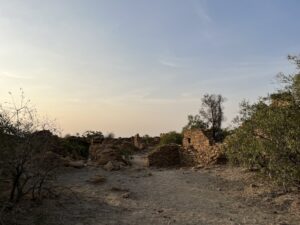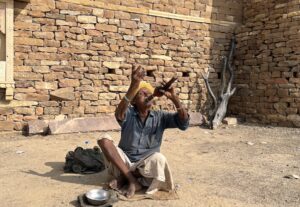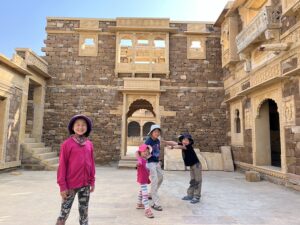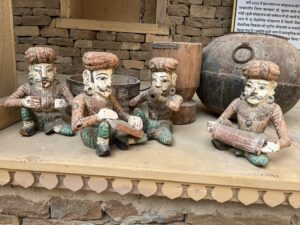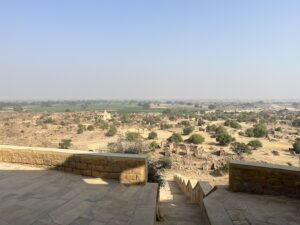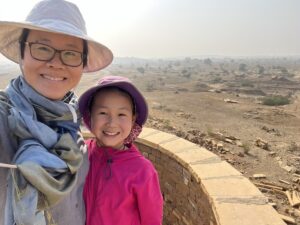On the way back to our tented camp, the driver suggested we stop by a haunted village. Ok, sure. We weren’t sure what to expect but we just went with it. We arrived at a village in the desert and besides being deserted, it looked no different from any that you could imagine. There were areas that were freshly renovated and there were areas that were nothing more than crumbling brick walls. Without any betrayal of emotion, the driver told us that ghosts and evil spirits lived here. Apart from a few stray dogs, we didn’t sense anything unusual. No paranormal activity here, just the kids trying to scare each other with creepy stories and noises.
While wandering around the village, we found a plaque that explained that Kuldhara was an ancient village inhabited by Pali Brahmins about 300 years ago. There were once 84 villages similar to this one but they were all mysteriously abandoned abruptly due to unknown reasons. Strangely, the villages were never reinhabited by the original inhabitants or newcomers despite having good structures and a water source.
The legend that locals like to tell is that the villages were haunted because of a curse placed on them. About 200 years ago, the prime minister of Jaisaler was an evil and selfish man named Salim Singh. Salim Singh wanted to marry the daughter of the village head of Kuldhara but she did not love him and rebuffed his advances. Being a man who liked to get what he wants, if she continued to refuse him, he insisted on marrying her by force. He threatened the village head with grave consequences if he did not approve of the marriage.
The Paliwal Brahmins were a proud and just people and they refused to submit to the whims of the prime minister. Instead of condoning the marriage, the heads of all 84 villages agreed to abandon their home and move far away from the reaches of the prime minister. Before they left, they put a curse on Kuldhara so that no others could ever inhabit the village. So to this day, those brave enough to attempt even an overnight stay have been chased away by the ghosts of the village.
Above Kuldhara Village are the ruins of a deserted fort called Khaba Fort. A few days later on our way into the desert, Nabu suggested we stop by to take a look. We didn’t know anything about Khaba Fort, but we were glad we stopped to take a look. It helped to give more context to the legend of Kuldhara and the 84 abandoned villages in the Thar Desert.
Just like when we visited Kuldhara Village, Khaba Fort was completely deserted. During our visit, we encountered only two other people, both at the front gate of the fort – one was the man in the ticket booth selling tickets and the other was an elderly man playing a wind instrument called a pungi, the instrument of choice for snake charmers. Both of them were waiting for tourists to arrive, but I doubt many did.
Khaba Fort was built in the 14th century by the Paliwal Brahmins and for hundreds of years, it was bustling with life. The shops, homes and temples have long since been abandoned by reasons unknown. It is much more modest than the royal forts and palaces of Rajasthan, but impressive nonetheless.
When we visited, it was apparent that there had been some restoration work done on parts of the fort. Sadly, there were no information boards or other historical information about the fort so we explored aimlessly for a while before heading back to the jeep.
We asked Nabu what he thought about the legend of Kuldhara. He said that nobody knows what caused the villages to become abandoned but all of the locals work hard to keep the legend and mystery alive. Abandoned villages inhabited by ghosts attract more tourists than abandoned villages without ghosts.
Author
-

Song is the mother of four children. She and her family have stepped away from it all and in September 2023, began traveling the world while homeschooling. Song is an ABC (American born Chinese) and has an undergraduate degree from Cornell and an MBA from Harvard. She is an entrepreneur and an educator. Her hobbies include learning, traveling, reading, cooking and baking, and being with children.



